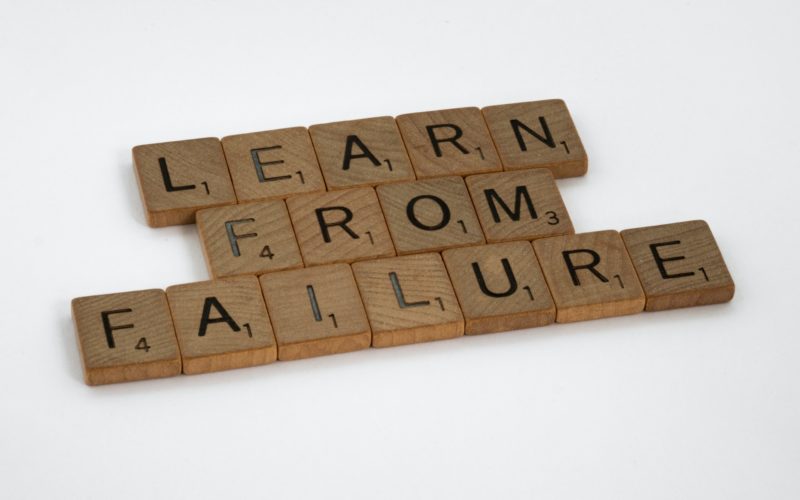One of the traits that define a leader is how they handle failure. In business, all managers face failures of different sorts, big and small, mostly resulting from poor business decisions, bad hires, and inadequate planning. Some managers try to cover up failures or even blame others. Others are so afraid of failure, they simply ignore it. A successful manager, however, openly embraces failure, both as a learning opportunity and a way to lead employees by example moving forward.
First of all, remember that most failures come when an organization or team is growing or making progress or changes. Lack of failure is a sure sign of stagnation. What’s more, failures can be a blessing in disguise, alerting you to blind spots or issues which when dealt with early on can prevent more-severe problems down the line.
Lessons from Failure
The biggest lesson failure teaches us is humility. Few leaders earn the true respect of their employees or team members without it. It’s essential to accept our shortcomings and know we will never be perfect.
Remember, team members are just as terrified of failure as their leaders. When leaders openly accept failure, show humility, and take responsibility, they connect with their team members and earn a new level of trust. Business leaders who fail to show humility and take responsibility earn just the opposite: distrust and disdain.
Failure also teaches us resilience. We are pushed to find the courage to keep trying, to find new ways of doing things. There’s a common lesson taught in youth sports: If you don’t make mistakes, you won’t learn, and you probably aren’t trying hard enough. This lesson applies to business leaders, as well.
Flexibility is another trait we pick up from our mistakes. Business leaders must keep trying, they must learn from their failures and innovate. At times, that means thinking on their feet, and at times that means taking time to reflect and identify what went wrong.
The history of the company Apple is a study of failure leading to success. Remember the Apple Lisa, the first desktop computer with a graphic user interface? Most people don’t, because for $10,000 (in 1983) the product utterly flopped, ultimately putting Steve Jobs out of a job. * But without the failures of the Lisa for Apple to learn from, we would not have the Apple Mac. Likewise, Apple’s 1993 personal digital assistant, the Apple Newton, was a massive flop, but it laid the groundwork for the iPod and iPhone.
Turning Failure into Success
It seems counterintuitive to encourage team members to make mistakes, but it’s something good leaders do. Failures are essential ingredients for success. Especially in today’s tech-savvy workplace, innovation is essential, and learning the correct ways to innovate requires the courage to fail along the way. Once again: If you never fail, you’re not trying hard enough.
Success doesn’t grow in a vacuum, and that’s a perfect example. Unhappy with his Hoover vacuum cleaner, James Dyson set out to make a better one. Dyson went through more than five thousand prototypes—five thousand failures—before he got it right, and even then, he had a product no appliance manufacturers wanted. He had to launch his own manufacturing company and spend ten years getting his product accepted in its first market, the UK. Today, “the Dyson” is a household name globally; the company has 12,000 employees and more than $7 billion in annual revenue.
To overcome failure, we need to work smarter, not harder. Examine what went wrong and fix it, then come up with a new plan going forward. A great way to do that is to turn to team members for help. Saying “Hey, guys, I made a mistake” or “We’ve been doing things wrong” is sure to grab their attention. Eliciting team members’ opinions and feedback makes them all part of the response to a problem, and when you begin a new action plan, they’ll feel a part of that, too, and be fully on board.
It is essential for leaders—and companies—to regularly gather feedback from customers, users, and partners. For everything from household appliances to websites’ user interfaces, prototype testing is crucial to success. Prototypes have bugs and flaws—failures—and prototype testing with user groups is the way to identify them.
Another failure to success story is of the Marvel Entertainment Group, the publisher of comic books. In 1998 after heavy losses in revenue, Marvel was delisted from the New York Stock Exchange just seven years after going public. The company declared Chapter 11 bankruptcy in 1996. Still, Marvel executives examined the company’s failures and developed a new business model. Marvel merged with the toymaker Toy Biz and focused on feature films. It worked with other film studios to create hits such as Spider-Man and X-Men, helping make superheroes the cinema staple they are today. A decade later in 2009, Disney bought Marvel for $4 billion.
Marvel had to embrace its mistakes. By the 1990s, the comic book industry was not what it was in the 1940s and 1950s. But company executives recognized the powerful appeal of their superheroes with dark sides and pasts and identified a better vehicle for the market of the day, movies.
So again, failure is just one side of the coin named success. Business leaders should embrace a workplace culture where mistakes are embraced as a part of growth. And they must acknowledge failures and shortcomings. Thus leading by example is the best way to foster the trust and the courage that employees need to innovate.
Footnote:
* Steve Jobs went on to lead Pixar Animation Studios to tremendous success. Jobs turned the small company from the computer division of Lucasfilm to a producer of blockbuster movies like Toy Story and its sequels. In 2006, Disney bought Pixar for $7.4 billion. As for Jobs, he returned to Apple in 1997, four years before the Apple iPod changed the way people listen to music.
⸻

Demos Parneros is an experienced and innovative retail and e-commerce leader, helping Staples grow from a startup to a Fortune 100 company, serving as President of North American Retail and E-commerce businesses. He subsequently took on the role of CEO at Barnes & Noble, leading a focused transformation plan, which eventually led to the sale of the company. In addition to previously serving on several high-profile company boards, Demos now leads CityPark LLC, where he has invested in 15 companies, including several leading-edge retail tech startups.












